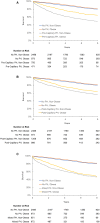Obesity Is Associated With Pulmonary Hypertension and Modifies Outcomes
- PMID: 32079475
- PMCID: PMC7335575
- DOI: 10.1161/JAHA.119.014195
Obesity Is Associated With Pulmonary Hypertension and Modifies Outcomes
Abstract
Background Experimental studies support a link between obesity and pulmonary hypertension (PH), yet clinical studies have been limited. This study sought to determine the association of obesity and pulmonary hemodynamic measures and mortality in PH. Methods and Results We examined patients undergoing right-sided heart catherization (2005-2016) in a hospital-based cohort. Multivariable regression models tested associations of body mass index and pulmonary vascular hemodynamics, with PH defined as mean pulmonary artery pressure >20 mm Hg, and further subclassified into precapillary, postcapillary, and mixed PH. Multivariable Cox models were used to examine the effect of PH and obesity on mortality. Among 8940 patients (mean age, 62 years; 40% women), 52% of nonobese and 69% of obese individuals had evidence of PH. Higher body mass index was independently associated with greater odds of overall PH (odds ratio, 1.34; 95% CI, 1.29-1.40; P<0.001 per 5-unit increase in body mass index) as well as each PH subtype (P<0.001 for all). Patients with PH had greater risk of mortality compared with individuals without PH regardless of subgroup (P<0.001 for all). We found that obesity was associated with 23% lower hazard of mortality among patients with PH (hazard ratio, 0.77; 95% CI, 0.69-0.85; P<0.001). The effect of obesity was greatest among those with precapillary PH (hazard ratio, 0.57; 95% CI, 0.46-0.70; P<0.001), where obesity modified the effect of PH on mortality (P for interaction=0.02). Conclusions Obesity is independently associated with PH. PH is associated with greater mortality; this is modified by obesity such that obese patients with precapillary PH have lower mortality compared with nonobese counterparts. Further studies are needed to elucidate mechanisms underlying obesity-related PH.
Keywords: obesity paradox; pulmonary hypertension; right‐sided heart catheterization; survival analysis.
Figures


References
-
- Ogden CL, Carroll MD, Fryar CD, Flegal KM. Prevalence of obesity among adults and youth: United States, 2011–2014. NCHS Data Brief. 2015;219:1–8. - PubMed
-
- Ho JE, Enserro D, Brouwers FP, Kizer JR, Shah SJ, Psaty BM, Bartz TM, Santhanakrishnan R, Lee DS, Chan C, Liu K, Blaha MJ, Hillege HL, Van Der Harst P, Van Gilst WH, Kop WJ, Gansevoort RT, Vasan RS, Gardin JM, Levy D, Gottdiener JS, De Boer RA, Larson MG. Predicting heart failure with preserved and reduced ejection fraction. Circ Heart Fail. 2016;9:e003116. - PMC - PubMed
-
- McQuillan BM, Picard MH, Leavitt M, Weyman AE. Clinical correlates and reference intervals for pulmonary artery systolic pressure among echocardiographically normal subjects. Circulation. 2001;104:2797–2802. - PubMed
Publication types
MeSH terms
Grants and funding
LinkOut - more resources
Full Text Sources
Medical

